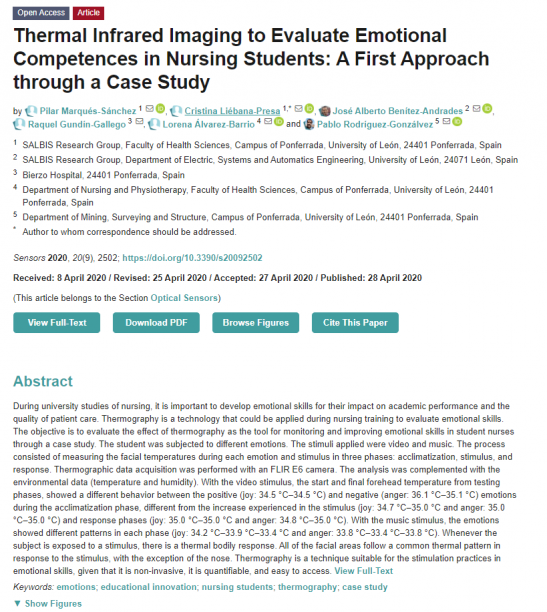Thermal Infrared Imaging to Evaluate Emotional Competences in Nursing Students: A First Approach through a Case Study
1 SALBIS Research Group, Faculty of Health Sciences, Campus of Ponferrada, University of León, 24401 Ponferrada, Spain
2 SALBIS Research Group, Department of Electric, Systems and Automatics Engineering, University of León, 24071 León, Spain
3 Bierzo Hospital, 24401 Ponferrada, Spain
4 Department of Nursing and Physiotherapy, Faculty of Health Sciences, Campus of Ponferrada, University of León, 24401 Ponferrada, Spain
5 Department of Mining, Surveying and Structure, Campus of Ponferrada, University of León, 24401 Ponferrada, Spain
* Author to whom correspondence should be addressed.
Sensors 2020, 20(9), 2502; https://doi.org/10.3390/s20092502
Received: 8 April 2020 / Revised: 25 April 2020 / Accepted: 27 April 2020 / Published: 28 April 2020
(This article belongs to the Section Optical Sensors)
During university studies of nursing, it is important to develop emotional skills for their impact on academic performance and the quality of patient care. Thermography is a technology that could be applied during nursing training to evaluate emotional skills. The objective is to evaluate the effect of thermography as the tool for monitoring and improving emotional skills in student nurses through a case study. The student was subjected to different emotions. The stimuli applied were video and music. The process consisted of measuring the facial temperatures during each emotion and stimulus in three phases: acclimatization, stimulus, and response. Thermographic data acquisition was performed with an FLIR E6 camera. The analysis was complemented with the environmental data (temperature and humidity). With the video stimulus, the start and final forehead temperature from testing phases, showed a different behavior between the positive (joy: 34.5 °C–34.5 °C) and negative (anger: 36.1 °C–35.1 °C) emotions during the acclimatization phase, different from the increase experienced in the stimulus (joy: 34.7 °C–35.0 °C and anger: 35.0 °C–35.0 °C) and response phases (joy: 35.0 °C–35.0 °C and anger: 34.8 °C–35.0 °C). With the music stimulus, the emotions showed different patterns in each phase (joy: 34.2 °C–33.9 °C–33.4 °C and anger: 33.8 °C–33.4 °C–33.8 °C). Whenever the subject is exposed to a stimulus, there is a thermal bodily response. All of the facial areas follow a common thermal pattern in response to the stimulus, with the exception of the nose. Thermography is a technique suitable for the stimulation practices in emotional skills, given that it is non-invasive, it is quantifiable, and easy to access. View Full-Text

